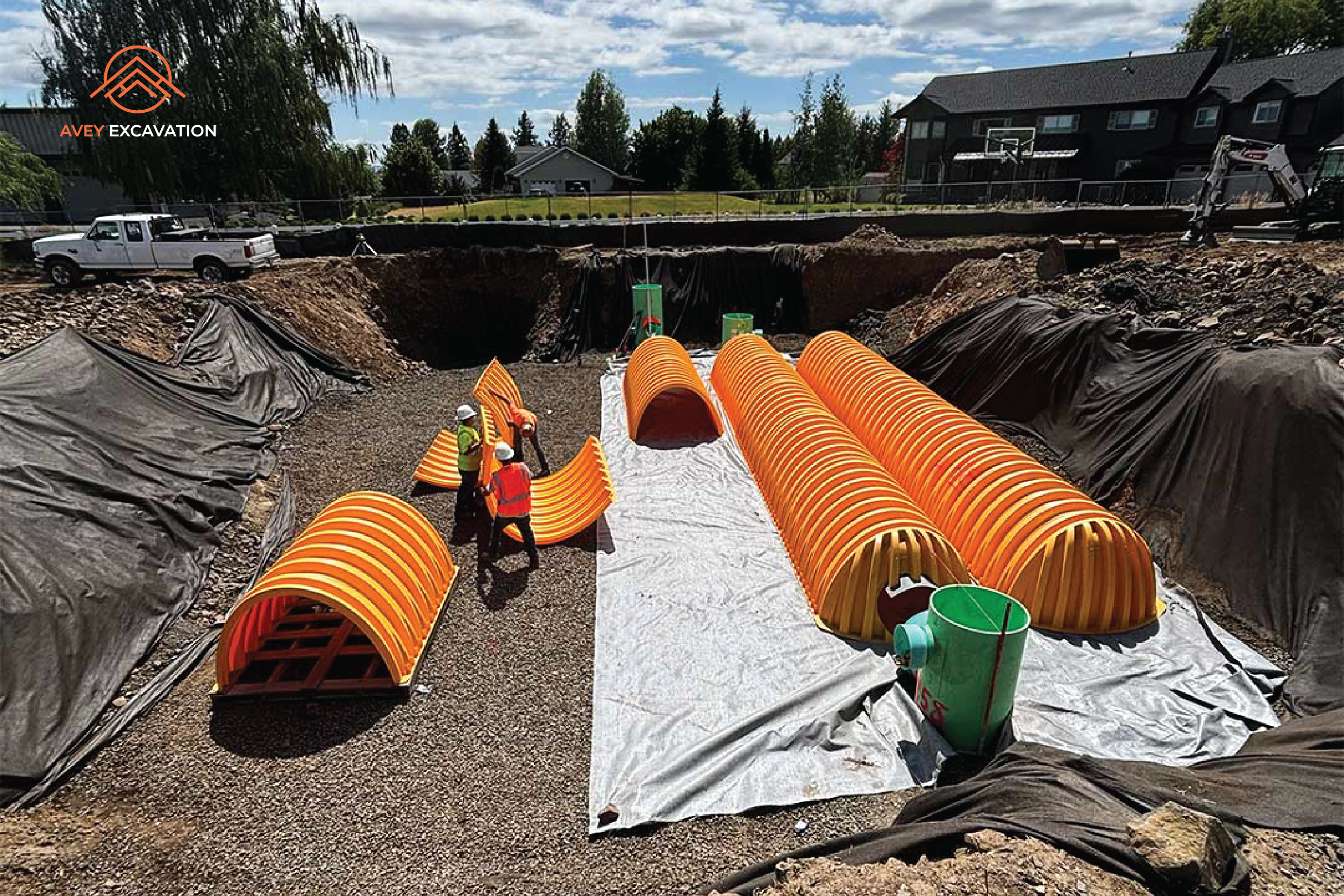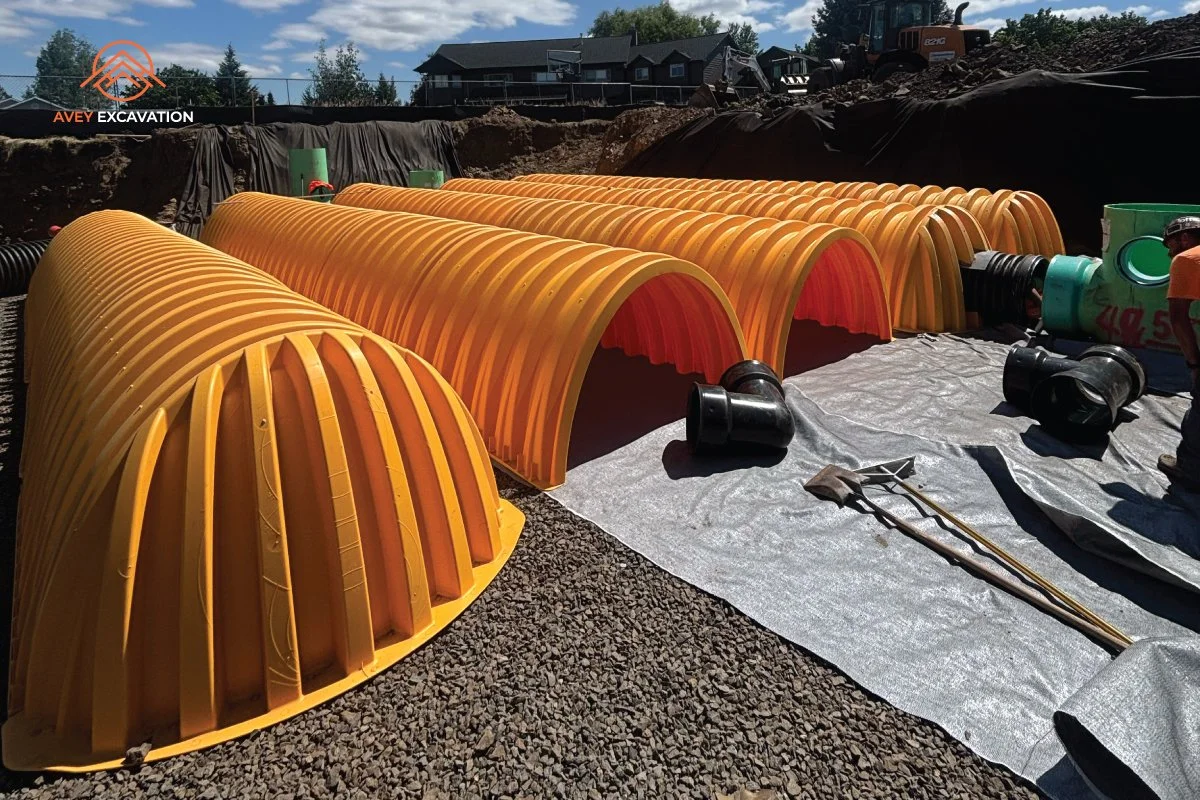Stormwater Solutions for Commercial Sites: Best Practices & StormTech Alternatives
Managing stormwater is a critical part of commercial construction. At one of our recent Spokane job sites, we installed the largest StormTech MC-3500 system ever delivered to the area—designed to control runoff, protect infrastructure, and support long-term site safety. In this article, we’ll share best practices for stormwater management and explore system alternatives that developers and property owners should know about.
Avey Excavation
What Is a Stormwater System?
A stormwater system is an underground or surface-level solution designed to control how rainwater and runoff move across a site. These systems help collect, store, and filter water during and after storms—protecting property, reducing flood risks, and keeping pollutants out of local waterways.
Common types of stormwater systems include:
Underground detention chambers (e.g., StormTech systems)
Bioswales and rain gardens
Permeable pavement
Retention ponds or modular tanks
Every commercial development requires a plan to manage stormwater efficiently and in line with local codes.
Why Stormwater Management Matters in Commercial Excavation
Stormwater control is essential to protect your site, nearby structures, and the surrounding community.
Reduces flooding and soil erosion
Maintains structural stability for buildings and roads
Prevents pollutants from entering storm drains and waterways
Ensures compliance with environmental regulations
Without proper planning, stormwater issues can delay construction, trigger costly repairs, or lead to fines.
Plan Early: Stormwater Strategy Begins Before Excavation
Effective drainage systems are part of the initial design process—not an afterthought.
Coordinate with engineers, architects, and excavation crews early on
Evaluate soil conditions, site slope, and existing utilities
Plan for future maintenance access and inspection points
Incorporate drainage needs into your grading and layout
Starting with a clear strategy saves time and money later in the build.
Best Practices for Site Drainage Systems
Stormwater systems should be tailored to site size, usage, and regulatory requirements.
Use underground detention chambers for high-volume runoff in commercial builds
Include sediment traps and filters to prevent clogs
Pair with proper site grading to direct flow away from foundations
Elevate walkways and pavement to reduce surface pooling
Verify compliance with local municipal codes and stormwater standards
These measures help prevent damage and streamline final inspections.
StormTech MC-3500: High-Capacity Detention in Action
For our Spokane-area project, we installed the StormTech MC-3500 system—a modular, underground chamber designed for large commercial runoff demands.
Key advantages include:
High-volume detention capacity for multifamily and commercial projects
Flexible layout for tight or irregular site footprints
Structural strength to support heavy traffic or parking above
Long-term performance with proper backfill and compaction
This system helps protect the neighborhood from flooding while keeping water clean and contained below ground.
Avey Excavation completed this installation as part of a larger development coordinated by Avey Construction Group. Operating under the same team structure allows us to fully integrate excavation into the overall construction schedule—resulting in a smoother, more efficient build. This unified approach streamlines sitework and supports faster, better-coordinated commercial development across the region.
Alternatives to StormTech Systems
Not every site requires a chamber system like the MC-3500. Depending on your location and goals, alternative stormwater solutions may be more appropriate.
Bioswales and rain gardens
Natural filtration for low-impact development or green building projects
Suited for landscaped areas or perimeter zonesPermeable pavers
Allows water to soak through surfaces like parking lots or walkways
Reduces surface runoff while maintaining usabilityModular tank systems
Stackable and space-efficient for urban developments
Good option when vertical clearance is limited
Each option comes with its own permitting requirements and maintenance needs.
The Role of Excavation in Stormwater System Performance
Excavation work plays a critical role in stormwater success. Poor installation can lead to future failures—even with a great design.
A skilled excavation team will:
Trench and place chambers or piping to exact specifications
Ensure soil compaction to avoid settlement or pipe movement
Prevent damage to adjacent utilities and infrastructure
Maintain separation between drainage materials and unsuitable soils
Experienced excavation contractors help ensure the system functions as designed—both now and in the future.
Conclusion: Build Smarter With Reliable Drainage Systems
Stormwater solutions are essential for every commercial development. Whether you’re working on an apartment complex, office park, or retail site, planning for drainage early helps avoid risks and protect the long-term value of your project.
Systems like the StormTech MC-3500 offer high-capacity protection, but there are also practical alternatives that may better suit your site. The key is working with knowledgeable contractors who can help you choose the right option—and install it correctly.
FAQ
-
High-volume systems like the StormTech MC-3500 are ideal for large developments. Smaller sites may benefit from bioswales or permeable surfaces.
-
Yes. Many underground detention systems are designed to be installed below traffic-bearing surfaces with proper backfill and compaction.
-
Start with a drainage plan from your civil engineer, and consult with your excavation contractor to determine what's feasible based on your site’s layout and soil.
-
Improper drainage can lead to flooding, erosion, water pollution, and failed inspections—all of which can delay or jeopardize your project.



